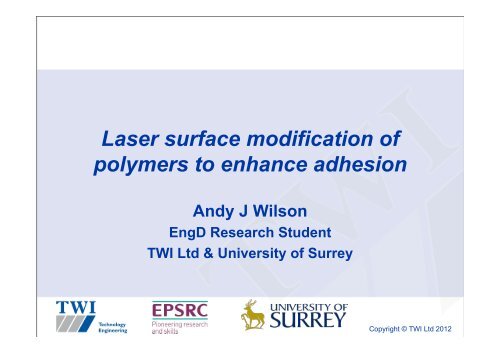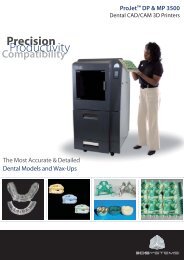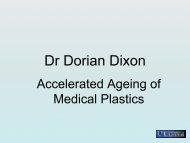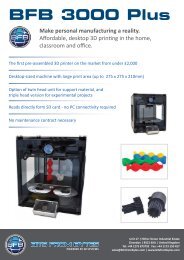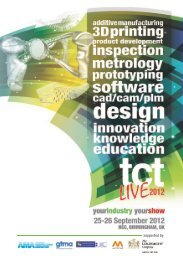Laser surface modification of polymers to enhance adhesion
Laser surface modification of polymers to enhance adhesion
Laser surface modification of polymers to enhance adhesion
Create successful ePaper yourself
Turn your PDF publications into a flip-book with our unique Google optimized e-Paper software.
<strong>Laser</strong> <strong>surface</strong> <strong>modification</strong> <strong>of</strong><br />
<strong>polymers</strong> <strong>to</strong> <strong>enhance</strong> <strong>adhesion</strong><br />
Andy J Wilson<br />
EngD Research Student<br />
TWI Ltd & University <strong>of</strong> Surrey<br />
Copyright © TWI Ltd 2012
Overview<br />
• Introduction <strong>to</strong> TWI<br />
• Introduction <strong>to</strong> University <strong>of</strong> Surrey EngD<br />
• Objectives<br />
• Surface <strong>modification</strong> by laser treatment<br />
• Surface characterisation<br />
• Concluding remarks<br />
• Future Work<br />
Copyright © TWI Ltd 2012
TWI introduction<br />
• Independent R&T organisation<br />
• Specialising in materials joining<br />
and related technologies<br />
• Non pr<strong>of</strong>it distributing<br />
• 770+ industrial members in 3500<br />
locations worldwide – All sec<strong>to</strong>rs<br />
• Five UK technical centres and<br />
eleven international training<br />
centres<br />
Cambridge<br />
Port Talbot<br />
• £60M+ turnover, 750+ staff<br />
Sheffield<br />
Middlesbrough<br />
Copyright © TWI Ltd 2012
Key industry sec<strong>to</strong>rs<br />
Aerospace Au<strong>to</strong>motive Construction<br />
Electronics Medical Oil & Gas Power<br />
Copyright © TWI Ltd 2012
TWI expertise in medical products<br />
• Materials<br />
• Failure Analysis<br />
• Surface Modification<br />
• Joining & Assembly<br />
• Packaging<br />
• Inspection and NDT<br />
• Manufacturing & Product Support<br />
• Training<br />
Copyright © TWI Ltd 2012
University <strong>of</strong> Surrey MiNMaT EngD<br />
• Four-year doc<strong>to</strong>ral programme for researchers who aspire<br />
<strong>to</strong> key leadership positions in industry.<br />
• Tackles an industrially relevant research innovation<br />
opportunity and incorporates a significant degree <strong>of</strong><br />
advanced characterisation.<br />
• The majority <strong>of</strong> the research is undertaken at the sponsor's<br />
premises.<br />
Copyright © TWI Ltd 2012
1. Polypropylene – Oil &<br />
Gas Sec<strong>to</strong>r<br />
• Improve <strong>adhesion</strong> <strong>of</strong><br />
PP insulation <strong>to</strong> PU<br />
field joint filler material<br />
Objectives<br />
Surface <strong>to</strong> be optimised<br />
Polypropylene insulation<br />
Area for polyurethane<br />
filler<br />
Copyright © TWI Ltd 2012
Objectives<br />
2. PEEK – Medical Sec<strong>to</strong>r<br />
PEEK images courtesy <strong>of</strong> Invibio ®<br />
• Surface<br />
<strong>modification</strong> <strong>of</strong><br />
Victrex ® PEEK<br />
(unfilled)<br />
• Nd:YAG laser,<br />
instead <strong>of</strong> a gas<br />
laser (e.g excimer)<br />
• Characterisation<br />
<strong>of</strong> PEEK <strong>surface</strong><br />
and measurement<br />
<strong>of</strong> adhesive<br />
performance<br />
Copyright © TWI Ltd 2012
Medical implants - PEEK<br />
Specific Tensile Modulus (10 6 Nm kg -1 )<br />
30<br />
25<br />
20<br />
15<br />
10<br />
5<br />
0<br />
Stiffness-<strong>to</strong>-weight ratios <strong>of</strong> implantable<br />
medical materials<br />
Cortical<br />
bone<br />
PEEK<br />
Medical<br />
Grade<br />
Stainless<br />
Steel<br />
Medical<br />
Grade<br />
Titanium<br />
Alloy<br />
Medical<br />
Grade<br />
Cobalt<br />
Chrome<br />
Alloy<br />
• PEEK increasingly<br />
used in long and<br />
short term<br />
implantable medical<br />
devices<br />
• Alternative <strong>to</strong><br />
traditional metallic<br />
alloys<br />
• Closer stiffness-<strong>to</strong>weight<br />
ratio <strong>to</strong> bone<br />
than metal alloys<br />
Data provided courtesy <strong>of</strong> Solvay Specialty Polymers<br />
Copyright © TWI Ltd 2012
Experimental approach<br />
Nd:YAG laser<br />
Weight Pulsed laser beam<br />
Sample<br />
• Nd:YAG Q-switched<br />
nanosecond pulse laser<br />
• Samples manipulated in a raster<br />
fashion using CNC X-Y table<br />
• Change power intensity <strong>to</strong><br />
influence <strong>surface</strong> <strong>of</strong> PEEK<br />
• Contact angle measurement<br />
used <strong>to</strong> characterise <strong>surface</strong>s.<br />
• Resulting <strong>adhesion</strong> measured<br />
using single lap shear<br />
• FTIR and XPS conducted <strong>to</strong><br />
characterise <strong>surface</strong> chemistry<br />
Copyright © TWI Ltd 2012
Experimental approach<br />
Nd:YAG laser<br />
Weight<br />
Pulsed laser beam<br />
Sample<br />
Untreated<br />
After laser<br />
treatment<br />
Copyright © TWI Ltd 2012
Surface characterisation<br />
• Surface characterisation conducted <strong>to</strong><br />
understand how laser <strong>surface</strong> treatment affects<br />
the <strong>surface</strong> chemistry <strong>of</strong> PEEK<br />
Contact angle/<strong>surface</strong> energy<br />
FTIR<br />
XPS<br />
Kruss Aglient Technologies Thermo Scientific<br />
Copyright © TWI Ltd 2012
Contact angle measurement<br />
• H 2 O and CH 2 I 2 liquids used <strong>to</strong> derive <strong>surface</strong> free energy <strong>of</strong><br />
PEEK <strong>surface</strong><br />
• Water contact angle reduces with increasing laser intensity<br />
Low water contact<br />
angle<br />
= good wettability<br />
= high <strong>surface</strong> energy<br />
Control<br />
= improved <strong>adhesion</strong><br />
Highest laser intensity<br />
Copyright © TWI Ltd 2012
PEEK <strong>surface</strong> energy<br />
Total Surface energy (mJ m -2 )<br />
Polar energy + disperse energy = <strong>to</strong>tal <strong>surface</strong> <br />
energy <br />
Power Intensity (W mm -2 )<br />
80 <br />
70 <br />
60 <br />
50 <br />
40 <br />
30 <br />
20 <br />
10 <br />
0 <br />
• Consistent <strong>surface</strong><br />
energy value up<br />
until laser intensity<br />
9.99x10 6 W mm -2<br />
• Increase in polar<br />
contribution <strong>to</strong><br />
<strong>surface</strong> energy<br />
(consistent with<br />
introduction <strong>of</strong><br />
polar functional<br />
groups)<br />
Copyright © TWI Ltd 2012
Lap shear testing<br />
• PEEK coupons bonded with Henkel Loctite 4061 (medical<br />
grade cyanoacrylate adhesive)<br />
• Overlap area 25 mm x 12.5 mm, test speed 1.3 mm min -1<br />
• <strong>Laser</strong> treatment increases lap shear strength by up <strong>to</strong> 13x<br />
Maximum load (N)<br />
2500.0<br />
2000.0<br />
1500.0<br />
1000.0<br />
500.0<br />
0.0<br />
Power Intensity (W mm -2 )<br />
Copyright © TWI Ltd 2012
Fourier transform infrared<br />
spectroscopy<br />
• Well documented and used<br />
method <strong>of</strong> analysing chemical<br />
properties <strong>of</strong> polymer <strong>surface</strong>s<br />
Control<br />
• Functional groups sought on<br />
laser treated sample. Resulting<br />
spectra appear identical, no<br />
changes observed.<br />
• Inconclusive - more <strong>surface</strong><br />
sensitive technique required.<br />
<strong>Laser</strong> treated<br />
Copyright © TWI Ltd 2012
X-ray pho<strong>to</strong>electron spectroscopy<br />
C1s O1s N1s Na1s S2p Si2p Cl2p <br />
C/O<br />
ratio <br />
Control 78.3 16.1 2.1 1.4 1.0 0.8 0.3 4.9 <br />
7.83 x 10⁶ W mm¯² 74.9 21.1 1.2 0.6 0 2.0 0.2 3.6 <br />
2.78 x 10 ⁷ W mm¯² 72.5 21.6 2.4 2.2 0 1.0 0.3 3.4 <br />
• Ratio <strong>of</strong> carbon/oxygen decreases with increasing laser<br />
intensity<br />
• Indicates <strong>surface</strong> is being oxidised.<br />
• Functional groups introduced on<strong>to</strong> <strong>surface</strong>, most likely<br />
carbonyls and carboxylic acids.<br />
• Further XPS analysis <strong>to</strong> continue.<br />
Copyright © TWI Ltd 2012
Concluding remarks<br />
• <strong>Laser</strong> treatment increases lap shear strength <strong>of</strong><br />
adhesively bonded PEEK lap joints<br />
• Decrease in contact angle shows increase in<br />
wettability and <strong>surface</strong> energy. Increase in polar<br />
<strong>surface</strong> energy shows functional groups created<br />
• FTIR is inconclusive, not <strong>surface</strong> sensitive<br />
enough – <strong>surface</strong> specific technique required<br />
• XPS shows increase in oxygen on PEEK;<br />
presence <strong>of</strong> functional groups consistent with<br />
increase in wettability and reduction in H 2 O<br />
contact angles.<br />
Copyright © TWI Ltd 2012
Further work<br />
• Further XPS analysis <strong>to</strong> be carried out <strong>to</strong> identify<br />
functional groups on PEEK <strong>surface</strong> and further<br />
characterise trace elements.<br />
• Further increase <strong>of</strong> laser intensity <strong>to</strong> achieve<br />
ablation <strong>of</strong> PEEK and other <strong>polymers</strong> for selective<br />
removal, <strong>to</strong> incorporate in<strong>to</strong> next commercial<br />
project at TWI.<br />
Copyright © TWI Ltd 2012
Thank you<br />
Questions?<br />
Copyright © TWI Ltd 2012


